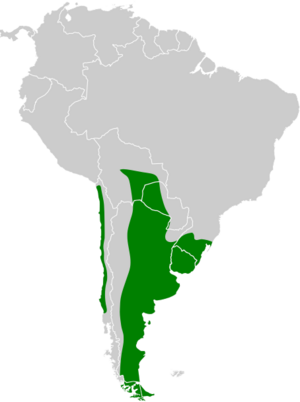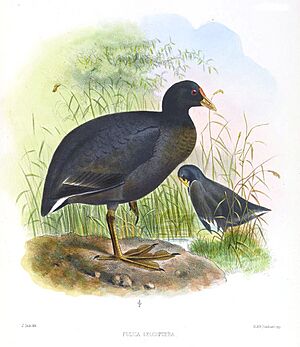White-winged coot facts for kids
Quick facts for kids White-winged coot |
|
|---|---|
 |
|
| Conservation status | |
| Scientific classification | |
| Genus: |
Fulica
|
| Species: |
leucoptera
|
 |
|
The white-winged coot (Fulica leucoptera) is a type of bird. It belongs to a family called Rallidae, which includes rails, gallinules, and other coots. You can find this bird in several South American countries. These include Argentina, Bolivia, Brazil, Chile, Paraguay, and Uruguay. It also lives on the Falkland Islands.
Contents
About the White-winged Coot
The white-winged coot is about 35 to 43 cm (14 to 17 in) long. It weighs around 400 to 600 g (14 to 21 oz). Male and female coots look very similar.
Adult coots have a yellow or greenish-yellow bill. They also have a small yellow or orange-yellow shield on their forehead. Their legs and feet are a pale sea green or yellow-green. Their toes and joints are blackish. Their feathers are a slaty gray color. The head and neck are even darker, almost black. They have white feathers under their tail. The tips of their wing feathers are wide and white. This is how the bird got its name!
Younger coots look a bit different. Immature birds have a dull olive bill. Their legs and feet are greenish-gray. Their upper body is gray-brown, and their underside is lighter. Very young coots, called juveniles, are dark gray. They have dark spots on their white head and neck.
Where White-winged Coots Live
You can find the white-winged coot in most of southern South America. They live in northern and central Chile. They are also found in eastern and southern Bolivia, Paraguay, and southeastern Brazil. From there, they spread south through Uruguay and Argentina, all the way to Tierra del Fuego. There's also a group of them living on the Falkland Islands. Sometimes, a coot might wander to Peru.
These birds love freshwater places. They live in lagoons, ponds, marshes, and quiet parts of rivers. They prefer areas with grassy or bare shores. They also like water with lots of plants growing underwater or floating duckweed. Sometimes, you might even see them in saltwater close to the shore.
How White-winged Coots Behave
Coot Movements
White-winged coots stay in southeastern Brazil all year long. In other places, they move around locally depending on the season.
What Coots Eat
White-winged coots mostly eat plants that grow in water. They also graze on grass on land, away from the water. When they are in the water, they usually eat from the surface. But sometimes, they will dive underwater to find food.
When they are not breeding, these coots like to be in groups. You can often see them in large flocks.
Reproduction and Life Cycle
The breeding season for white-winged coots changes depending on where they live. In the lowlands of Argentina, they breed from April to November. In higher areas, they breed from November to January. In Brazil, they nest during the southern summer.
These birds usually have one partner for life. They become very protective of their territory when they are breeding. They build a floating nest out of rushes and other plants. Sometimes, they build it among plants sticking out of the water. Other times, they build it on beds of floating plants. A female coot usually lays 10 to 12 eggs. Both parents help feed their young.
Coot Sounds
White-winged coots are very noisy birds! They make many loud, hollow cackling calls. They also make clucking sounds. Some of their calls even sound like human laughter. When male coots are being aggressive, they make a special "huc" sound.
White-winged Coot Status
The IUCN (International Union for Conservation of Nature) has said that the white-winged coot is a species of "Least Concern." This means they are not currently at risk of disappearing. They live across a very large area. We don't know exactly how many there are, but their numbers seem to be steady. Experts haven't found any immediate threats to them. They are generally considered common. In large marshes in the Argentinian Pampas, you can even see flocks of thousands of these birds!



